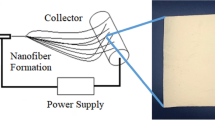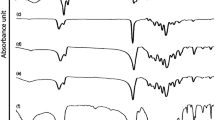Abstract
An innovative type of nanofibers-based form-stable composite phase change materials for the storage and retrieval of thermal energy was successfully prepared by encapsulating glycerol monostearate (GMS) into the porous structure of polyethylene terephthalate (PET)-supporting matrices on the nanoscale through electrospinning. The field-emission scanning electron microscopy and transmission electron microscopy images revealed that the composite nanofibers possessed desired morphologies with the average fiber diameters ranging from about 290 to 1000 nm which increased with the contents of GMS. The two phase separation (e.g., GMS phase and PET phase) was clearly observed from the images. When GMS content reached 60 %, the amount of the GMS distributing on the surface of the composite nanofibers was significantly increased during the electrospinning. The Fourier transform infrared spectroscopy spectrum proved that the PET supporting matrices were physically combined with GMS molecules. The differential scanning calorimetry analysis indicated that the GMS/PET composite nanofibers had reversible phase change behaviors, and the melting enthalpies increased from 32.63 to 66.99 kJ kg−1 with increasing GMS amount. The TG results showed that both the onset thermal degradation temperature and charred residue of the GMS/PET composite nanofibers at 700 °C were higher than those of pristine GMS powder owing to the better thermal stability of the PET molecules. The tensile testing revealed that the averaged tensile strength and elongation at break of the all GMS/PET composite nanofibers varied from 3.29 to 10.30 MPa and from 2.42 to 42.30 %, respectively.











Similar content being viewed by others
References
Sharma SD, Sagara K. Latent heat storage materials and systems: a review. Inter J Green Energy. 2005;2:1–56.
Kenisarin M, Mahkamov K. Solar energy storage using phase change materials. Renew Sust Energy Rev. 2007;11:1913–65.
Regin AF, Solanki SC, Saini JS. Heat transfer characteristics of thermal energy storage system using PCM capsules: a review. Renew Sust Energy Rev. 2007;12:2438–58.
Pasupathy A, Velraj R, Seeniraj RV. Phase change material-based building architecture for thermal management in residential and commercial establishments. Renew Sust Energy Rev. 2008;12:39–64.
Zalba B, Marin JM, Cabeza LF, Mehling H. Review on thermal energy storage with phase change: materials, heat transfer analysis and applications. Appl Therm Eng. 2003;2:251–83.
Farid MM, Khudhair AM, Razack SAK, Al-Hallaj S. A review on phase change energy storage: materials and applications. Energy Convers Manage. 2004;45:1597–615.
Zeng JL, Cao Z, Yang DW, Xu F, Sun LX, Zhang XF, Zhang L. Effects of MWNTs on phase change enthalpy and thermal conductivity of a solid-liquid organic PCM. J Therm Anal Cal. 2009;95:507–12.
Wang N, Zhang XR, Zhu DS, Gao JW. The investigation of thermal conductivity and energy storage properties of graphite/paraffin composites. J Therm Anal Cal. 2012;107:949–54.
Kao HT, Li M, Lv XW, Tan JM. Preparation and thermal properties of expanded graphite/paraffin/organic montmorillonite composite phase change material. J Therm Anal Cal. 2012;107:299–303.
Nikolic R, Cincovic MM, Gadzuric S, Zsigrai IJ. New materials for solar thermal storage-solid/liquid transitions in fatty acid esters. Sol Energy Mater Sol Cells. 2003;79:285–92.
Sari A, Eroglu R, Bicer A, Karaipekli A. Synthesis and thermal energy storage properties of erythritol tetrastearate and erythritol tetrapalmitate. Chem Eng Technol. 2011;34:87–92.
Aydin AA, Okutan H. High-chain fatty acid esters of myristyl alcohol with even carbon number: novel organic phase change materials for thermal energy storage-1. Sol Energy Mater Sol Cells. 2011;95:2752–62.
Li JL, Xue P, Ding WY, Han JM, Sun GL. Micro-encapsulated paraffin/high-density polyethylene/wood flour composite as form-stable phase change material for thermal energy storage. Sol Energy Mater Sol Cells. 2009;93:1761–7.
Cai YB, Wei QF, Huang FL, Gao WD. Preparation and properties studies of halogen-free flame retardant form-stable phase change materials based on paraffin/high density polyethylene composites. Appl Energy. 2008;85:765–75.
Ye H, Ge XS. Preparation of polyethylene-paraffin compound as a form-stable solid-liquid phase change material. Sol Energy Mater Sol Cells. 2000;64:37–44.
Alkan C, Kaya K, Sari A. Preparation, Thermal properties and thermal reliability of form-stable paraffin/polypropylene composite for thermal energy storage. J Polym Environ. 2009;17:254–8.
Wang LJ, Meng D. Fatty acid eutectic/polymethyl methacrylate composite as form-stable phase change material for thermal energy storage. Appl Energy. 2010;87:2660–5.
Sari A, Alkan C, Kolemen U, Uzun O. Eudragit S (methyl mathacrylate methacrylic acid copolymer)/fatty acid blends as form-stable phase change material for latent heat thermal energy storage. J Appl Polym Sci. 2006;101:1402–6.
Pielichowska K, Głowinkowski S, Lekki J, Binias D, Pielichowski K, Jenczyk J. PEO/fatty acid blends for thermal energy storage materials. Structural/morphological features and hydrogen interactions. Eur Polym J. 2008;44:3344–60.
Pielichowski K, Flejtuch K. Recent developments in polymeric phase change materials for energy storage: poly(ethylene oxide)/stearic acid blends. Polym Adv Technol. 2005;16:127–32.
Pielichowski K, Flejtuch K. Thermal properties of poly(ethylene oxide)/lauric acid bleds: a SSA-DSC study. Thermochim Acta. 2006;442:18–24.
Sari A, Alkan C, Karaipekli A, Onal A. Preparation, characterization and thermal properties of styrene maleic anhydride copolymer (SMA)/fatty acid composites as form stable phase change materials. Energ Convers Manage. 2008;49:373–80.
Fang YT, Kang HY, Wang WL, Liu H, Gao XN. Study on polyethylene glycol/epoxy resin composite as a form-stable phase change material. Energ Convers Manage. 2010;51:2757–61.
Alkan C, Sari A, Uzun O. Poly(ethylene glycol)/acrylic polymer blends for latent heat thermal energy storage. AIChE J. 2006;52:3310–4.
Ke GZ, Xie HF, Ruan RP, Yu WD. Preparation and performance of porous phase change polyethylene glycol/polyurethane membrane. Energ Convers Manage. 2010;51:2294–8.
Chen CZ, Wang LG, Huang Y. Electrospinning of thermo-regulating ultrafine fibers based on polyethylene glycol/cellulose acetate composite. Polymer. 2007;48:5202–7.
Chen CZ, Wang LG, Huang Y. Electrospun phase change fibers based on polyethylene glycol/cellulose acetate blends. Appl Energy. 2011;88:3133–9.
Thuy TTN, Lee JG, Park JS. Fabrication and characterization of coaxial electrospun polyethylene glycol/polyvinylidene fluoride (core/sheath) composite non-woven mats. Macromol Res. 2011;19:370–8.
Seifpoor M, Nouri M, Mokhtari J. Thermo-regulating nanofiber based on nylon 6,6/polyethylene glycol blend. Fiber Polym. 2011;12:706–14.
Deitzel JM, Kleinmeyer J, Harris D, Tan NCB. The effect of processing variables on the morphology of electrospun nanofibers and textiles. Polymer. 2001;42:261–72.
Zong XH, Kim K, Fang DF, Ran SF, Hsiao BS, Chu B. Structure and process relatinship of electrospun bioabsorbable nanofiber membranes. Polymer. 2002;43:4403–12.
Huang ZM, Zhang YZ, Kotaki M, Ramakrishna S. A review on polymer nanofibers by electrospinning and their applications in nanocomposites. Compos Sci Technol. 2003;63:2223–53.
Theron SA, Zussman E, Yarin AL. Experimental investigation of the governing parameters in the electrospinning of polymer solutions. Polymer. 2004;45:2017–30.
Tungprapa S, Puangparn T, Weerasombut M, Jangchud I, Fakum P, Semongkhol S, Meechaisue C, Supaphol P. Electrospun cellulose acetate fibers: effect of solvent system on morphology and fiber diameter. Cellulose. 2007;14:563–75.
Hardick O, Stevens B, Bracewell DG. Nanofibre fabrication in a temperature and humidity controlled environment for improved fibre consistency. J Mater Sci. 2011;46:3890–8.
Greiner A, Wendorff JH. Electrospinning: a fascinating method for the preparation of ultrathin fibers. Nanotechnology. 2007;46:5670–703.
Holland BJ, Hay JN. Analysis of comonomer contents and cyclic oligomers of poly(ethylene terephthalate). Polymer. 2002;43:1797–840.
Esrafilzadeh D, Jalili R, Morshed M. Crystalline order and mechanical properties of as-electrospun and post-treated bundles of uniaxially aligned polyacrylonitrile nanofiber. J Appl Polym Sci. 2008;110:3014–22.
Lee J, Deng YL. Increased mechanical properties of aligned and isotropic electrospun PVA nanofiber webs by cellulose nanowhisker reinforcement. Macromol Res. 2012;20:76–83.
Baji A, Mai YW, Wong SC, Abtahi M, Chen P. Electrospinning of polymer nanofibers: effects on oriented morphology, structures and tensile properties. Compos Sci Technol. 2010;70:703–18.
Huang ZM, Zhang YZ, Ramakrishna S, Lim CT. Electrospinning and mechanical characterization of gelatin nanofibers. Polymer. 2004;45:5361–8.
Marsano E, Francis L, Giunco F. Polyamide 6 Nanofibrous Nonwovens via Electrospinning. J Appl Polym Sci. 2010;117:1754–65.
Liao CC, Wang CC, Shih KC, Chen CY. Electrospinning fabrication of partially crystalline bisphenol A polycarbonate nanofibers: effects on conformation, crystallinity, and mechanical properties. Eur Polym J. 2011;47:911–24.
Hou XX, Yang XP, Zhang LQ, Waclawik E, Wu SZ. Stretching-induced crystallinity and orientation to improve the mechanical properties of electrospun PAN nanocomposites. Mater Des. 2010;31:1726–30.
Gaudio CD, Ercolani E, Nanni F, Bianco A. Assessment of poly(ε-caprolactone)/poly(3-hydroxybutyrate-co-3-hydroxyvalerate) blends processed by solvent casting and electrospinning. Mater Sci Eng A. 2011;528:1764–72.
Tang CY, Chen PP, Liu HQ. Cocontinuous cellulose acetate/polyurethane composite nanofiber fabricated through electrospinning. Polym Eng Sci. 2008;48:1296–303.
Shivakumar E, Pandey KN, Alam S, Das CK. Influence of interactions on the mechanical, morphological and thermal properties of in situ ternary composites based on fluorocarbon elastomer, acrylic elastomer and liquid crystalline polymer blends. Polym Int. 2005;54:1458–65.
Correlo VM, Boesel LF, Bhattacharya M, Mano JF, Neves NM, Reis RL. Properties of melt processed chitosan and aliphatic polyester blends. Mater Sci Eng. 2005;403:57–68.
Acknowledgements
This research was financially supported by the National High-tech R&D Program of China (No.2012AA030313), Changjiang Scholars and Innovative Research Team in University (No.IRT1135), the National Natural Science Foundation of China (No.51006046 and No.51203064), the Priority Academic Program Development of Jiangsu Higher Education Institutions, the Industry-Academia-Research Joint Innovation Fund of Jiangsu Province (BY2012068), the Science and Technology Support Program of Jiangsu Province (SBE201201094), the Natural Science Fundation of Jiangsu Province (BK2010140), the Doctor Candidate Foundation of Jiangnan University (JUDCF12023), and the Innovation Program for Graduate Education in Jiangsu Province (No. CXZZ12_0747).
Author information
Authors and Affiliations
Corresponding author
Rights and permissions
About this article
Cite this article
Ke, H., Li, D., Wang, X. et al. Thermal and mechanical properties of nanofibers-based form-stable PCMs consisting of glycerol monostearate and polyethylene terephthalate. J Therm Anal Calorim 114, 101–111 (2013). https://doi.org/10.1007/s10973-012-2856-7
Received:
Accepted:
Published:
Issue Date:
DOI: https://doi.org/10.1007/s10973-012-2856-7




